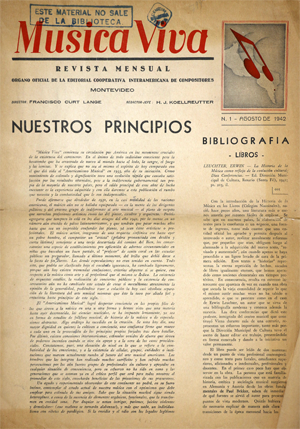Música viva
Prepared by Gabriel Caballero
Introduction by Benjamin Knysak
Online only (2020)

Only one issue of Música viva: Revista mensual was known to have been published. Appearing in August of 1942 and directed by the German-born musicologist Francisco Curt Lange and edited by Hans Joachim Koellreutter, Música viva was the official organ of the Editorial Cooperativa Interamericana de Compositores, the publishing arm of the Instituto Interamericano de Musicología, founded by Lange in 1938 with endorsement from the First Inter-American Conference in the Field of Music held in Washington, D.C. in 1939. The goals of the Insitituto focused on inter-American cooperation in the many facets of music, including musicology, composition, pedagogy, and folklore. As such, Música viva was to serve as a musical news- and review-oriented publication, in contrast to Lange’s larger, scholarly Boletín Latino-Americano de Música which was published in irregular installments between 1935 and 1946.
The single issue of Música Viva reflects Lange’s pan-American vision. Beginning with Lange’s statement of his vision for the journal, the Instituto, and the Editorial Cooperativa, two unsigned reviews follow, one of Erwin Leuchter’s La Historia de la Música Como Reflejo de la Evolución Cultural and the other of Aaron Copland’s article on “The Composers of South America,” originally published in Modern Music. Charles Seeger of Washington, D.C. contributed an article on the cultural understanding of folk and popular music, the Brazilian writer Mario de Andrade analyzed the composer Francesco Mignone's recent works, and Diego Errandonea summarized the musical season in Montevideo. Juan Carlos Paz wrote on music in Argentina pre-1915. The issue concludes with musical news from throughout the hemisphere.
It is unclear why only one issue appeared, though Lange initially intended Música viva to be a monthly publication. This RIPM Index was prepared from a copy held by the Library of Congress.
